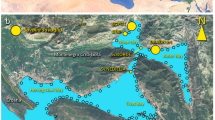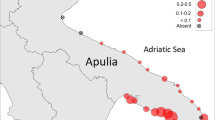Abstract
AN interesting and unusual spatfall of the common mussel, Mytilus edulis, on the common cockle, Cardium edule, resulting in a related and dual mortality was observed in 1932 in the course of investigations on the extensive cockle beds of Cark sands at the head of Morecambe Bay. In June, heavy falls of mussel spat (5–10 mm. long) were found in several large areas on these beds, an event unprecedented in the experience of local middle-aged fishermen. At low water on these desert-like sands, the areas with mussels loomed in the distance like rocky outcrops. Such an unusual spatfall may be regarded as a natural experiment on the part of Mytilus to establish itself on sandy ground.
This is a preview of subscription content, access via your institution
Access options
Subscribe to this journal
Receive 51 print issues and online access
$199.00 per year
only $3.90 per issue
Buy this article
- Purchase on Springer Link
- Instant access to full article PDF
Prices may be subject to local taxes which are calculated during checkout
Similar content being viewed by others
References
R. W. Dodgson, Fishery Invest. II, 10, 1, p. 160, 1928.
J. T. Jenkins, Lancs. and Western Sea Fish. District, Quartely Reports, Preston.
J. H. Orton and H. M. Lewis, J. Mar. Biol. Assoc., 17, 2; 1931.
J. Johnstone, L.M.B.C. Memoir II, p. 20, 1899.
J. H. Orton, J. Mar. Biol. Assoc., 9, 3, 459; 1912.
C. M. Yonge, ibid., 16, 2, 331; 1926.
Author information
Authors and Affiliations
Rights and permissions
About this article
Cite this article
ORTON, J. Strange Spatfall of the Common Mussel on the Common Cockle. Nature 131, 513–514 (1933). https://doi.org/10.1038/131513c0
Issue Date:
DOI: https://doi.org/10.1038/131513c0
This article is cited by
Comments
By submitting a comment you agree to abide by our Terms and Community Guidelines. If you find something abusive or that does not comply with our terms or guidelines please flag it as inappropriate.



